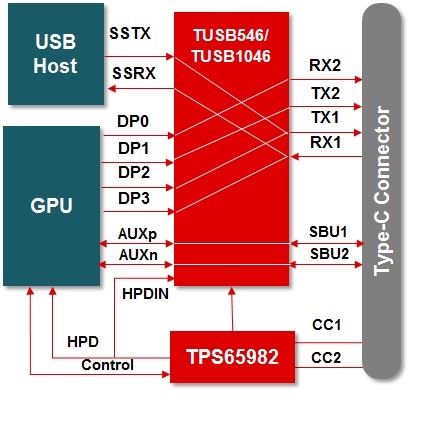SSZTAQ5 october 2016 TPS65982 , TUSB1002 , TUSB1042I , TUSB1046-DCI , TUSB1046A-DCI , TUSB501 , TUSB522P , TUSB542 , TUSB544 , TUSB546A-DCI , TUSB551 , TUSB564
The USB Type-C connector is quickly becoming the de-facto interface in consumer devices, as it supports multiple data and video standards including USB and DisplayPort™. The USB 3.1 standard specifies USB data rates up to 10Gbps over USB Type-C. At these higher data rates, maintaining signal integrity over the entire data channel is essential to meeting the maximum supported performance of each device.
Several items can contribute to signal integrity issues, including channel loss, intersymbol interference (ISI) and signal reflections caused by impedance mismatches occurring during the transition from printed circuit board (PCB) to cable and vice versa. As signals traverse through a channel, the amplitude of the signal is attenuated; the attenuation varies depending on the frequency content of the signal. Depending on the length of the channel, this attenuation could be large enough to result in signal integrity issues at high data rates.
A redriver is a signal conditioning device. It recovers a signal that has become lossy over a given channel, and it boosts the output of that recovered signal, allowing a longer distance for that signal to travel. Redrivers have configurable equalization settings that can help recover a signal due to ISI and/or channel loss. Redrivers can also increase the amount of DC in a recovered signal. Both the configurable equalization (EQ) and DC gain can also help pass system electrical and protocol compliance testing, and increase interoperability among devices. Without a redriver, the total transmission channel distance for a given signal can be limited.
For USB 3.1 Gen 2 systems, the insertion loss budget over a USB Type-C port is 8.5dB, with an additional 6.5dB of loss budgeted for the USB Type-C cable, resulting in a total budgeted loss of 23.5dB. This loss budget only allows for less than a 1m USB Type-C cable and only a few inches of FR4 trace length at the host and device which limits the placement of devices and size of the PCB design. In order to maintain good signal quality for a USB Type-C Gen 2 system without limiting the size of the PCB and placement of devices, a redriver is the most cost-effective solution.
The Texas Instruments TUSB1046 is a Video Electronics Standards Association (VESA) USB Type-C Alternate Mode redriver switch supporting data rates up to 10Gbps for a downstream-facing port (host). Figure 1 is a block diagram of the TUSB1046 Alt Mode system implementation.
 Figure 1 TUSB1046 Alt Mode Block
Diagram for a Host
Figure 1 TUSB1046 Alt Mode Block
Diagram for a HostUsing the TUSB1046 USB Type-C redriver with a multiplexer addresses any signal integrity concerns on a typical motherboard where you cannot easily locate the host controller close to the USB Type-C connector. At the same time, the TUSB1046 provides the required USB Type-C multiplexer functionality needed to enable the flip-ability of the connector/cable interface. The TUSB1046 supports USB 3.1 Gen 2 signaling as well as DisplayPort 1.4, with Alt Mode options such as two-lane USB plus two-lane or four-lane DisplayPort, along with additional supported configurations.
Start evaluating your USB Type-C design quickly with the “TUSB1046 USB Type-C™ Alternate Mode Re-Driving Switch Up to 10Gbps Data Rates EVM (TUSB1046EVM).”
Additional Resources
- Download the 5Gbps Type-C redriver multiplexer TUSB546 data sheet.
- Read more about the TPS65982 USB Type-C USB Power Delivery controller power switch.